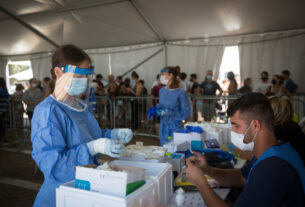The subject of Israeli children and teenagers who were held hostage by Hamas in Gaza has dominated headlies in recent days, but because of the content they are sharing on the social media platform TikTok.
Children and teenagers who were released from their captivity in Gaza have been uploading TikTok videos in which they dance, laugh, and even joke about their time as Hamas’s hostages – but these have evoked mixed emotions. While some find joy in seeing these children seemingly enjoying themselves, others wonder if their behavior is simply a coping mechanism.
We spoke to Dr. Efrat Baron-Harlev, director of Schneider Children’s Medical Center for Israel, who has provided care for 17 of the child hostages who were freed, to gain insight into their situation.
“It is important to understand that we treated 19 children, seven mothers, and one grandmother, so there is a wide age range and diversity among the hostages,” Baron-Harlev explained.
“Each child had their own identity, family, and personality prior to October 6. Then there is October 7 itself, when something happened that brought them to Gaza. Lastly, we must consider what they experienced during their time as hostages. When we take all these factors into account, the variables are endless.”
He continued: “Adolescence poses another dimension when considering these children. Interacting with teenagers on a daily basis is different, and… I have come to realize that they are the most vulnerable group. I am particularly concerned about those who appear happy and jubilant, dancing on TikTok, as well as those who are quiet and introverted – and everything in between.”
Gaza hostages sent home: Why are teenagers the most vulnerable demographic?
“Teenagers, regardless of their personality, tend to think they can handle things on their own, with minimal assistance. Just like adults, they dislike constantly relying on help and prefer to cope independently. This mindset leads them to deal with adversity in ways that may not be productive,” the doctor explained. “Therefore, we must closely monitor their behavior as it deviates from the norm, and we struggle to decipher whether they are truly distressed.”
She emphasized that there are no easy answers in this case. “We must not assume we know how to provide for these children, because we don’t.”
Helping children freed from Gaza: What challenges lie ahead?
“We have no idea what the future holds for them, but I want to convey an essential message to the children and their families: At Schneider, we strive to be their unwavering support – whether they need it or not,” she said. “We are here for them during the day or in the middle of the night. Moreover, we aim for collaborative efforts between the hospital and the community, establishing a holistic approach. We have never faced a situation like this, and our goal is to be a constant pillar of support for these children.”
אני מת על זה שהנערים והנערות שיצאו מהשבי פשוט מעלים סרטונים לטיקטוק כאילו הכל נורמלי pic.twitter.com/KkLW95XFUG
— EK (@bathlizard) December 3, 2023
The challenges faced by the children and their families are immense.
“Firstly, most families do not have a home to return to. The place they are going back to is not their real home. They long for the familiarity of their own bed – a simple desire that any child would have,” Baron-Harlev said. “Secondly, it is difficult for all of us to go back to normal, so for these children, the biggest challenge may be adapting to a new daily routine. Routine is crucial.”




